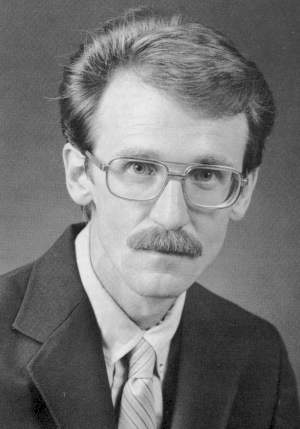
|
 |
|
{Page 73}
| Top of Page | Table of Contents | Home |

Don Thompson, a native of Oklahoma, began his studies in chemistry and mathematics at Northeastern State College (now, University) in Tahlequah where he received a B.S. degree in 1965. He entered graduate school in 1965 at the University of Arkansas in Fayetteville, and studied with Professor Richard N. Porter. In 1969, he was invited to the Los Alamos National Laboratory for three months as a Visiting Staff Member. He received his Ph.D. in 1970, spent a postdoctoral year with Professor Don L. Bunker at the University of California, Irvine, then returned to Los Alamos as a research staff member. There he developed a research program in theoretical chemical dynamics. The emphasis of his early research at Los Alamos was on the development of theoretical techniques and computational studies of the chemical dynamics of fundamental processes ranging from collisional energy transfer to homogeneous nucleation. He joined the faculty at Oklahoma State University in 1983, where he is Professor of Physical Chemistry.
Don carried out the first realistic dynamics studies of collisional vibrational and rotational relaxation. This work demonstrated how to calculate accurate vibrational relaxation rates and provided insight into the complex mechanisms by which energy transfer occurs. This research showed that the formation of collision complexes importantly enhances the rates of energy transfer, that symmetric atom-exchange reactions can lead to extremely fast energy transfer, and that vibrational-rotational resonances significantly affect vibrational relaxation; the results spawned studies by other researchers. He also developed techniques for non-global, analytical representations of ab initio potential energy surfaces, an approach that has been widely used by others. He also carried out one of the most extensive and accurate quantum mechanical calculations of a potential energy surface that had been computed at that time.
Towards the end of his tenure at Los Alamos, he turned his attention to several other research areas such as ion-molecule clustering, homogeneous nucleation, van der Waals molecules, and unimolecular reactions. Perhaps most important was the first classical dynamics calculation for the vibrational predissociation of a van der Waals molecule; the results had a significant effect on accepted ideas about the fundamental nature of unimolecular dynamics. An outgrowth of this work was a series of studies of homogeneous nucleation. His studies of the early stages for homogeneous nucleation of argon represented a unique approach to the problem of cluster growth. A natural extension was the study of the dynamics of neutrals clustering upon a central ion.
At Los Alamos, Don became interested in unimolecular reactions and gas/surface chemistry; at OSU he has made extensive studies of unimolecular reactions, intramolecular relaxation, and gas-surface processes such as adsorption/desorption, recombination, diffusion, chemical reactions, scattering, and adatom-surface energy transfer.
The theme of Don's research in gas/solid surface chemistry are realistic results for the dynamics of chemical reactions occurring at an interface. He, in collaboration with Dr. Lionel Raff, has carried out an intensive program in dynamical and statistical theoretical calculations of various processes that occur at the gas-solid interfaces in silicon systems.
Don maintains an active research group at OSU. Since 1983, he has graduated one M.S. and two Ph.D. students, and his group currently comprises four Ph.D. candidates and three postdoctoral associates. His research has received continuous financial support from federal agencies, including grants for state-of-the-art computing equipment. He has published over 100 papers in refereed, international journals. Last year, he gave 11 invited talks on his research, and he was one of 12 invited participants at a CECAM workshop at Orsay, France. In 1987, he served as a MASUA Honor Lecturer and the year before he was the OSU Sigma Xi chapter lecturer.
| Top of Page | Table of Contents | Home |